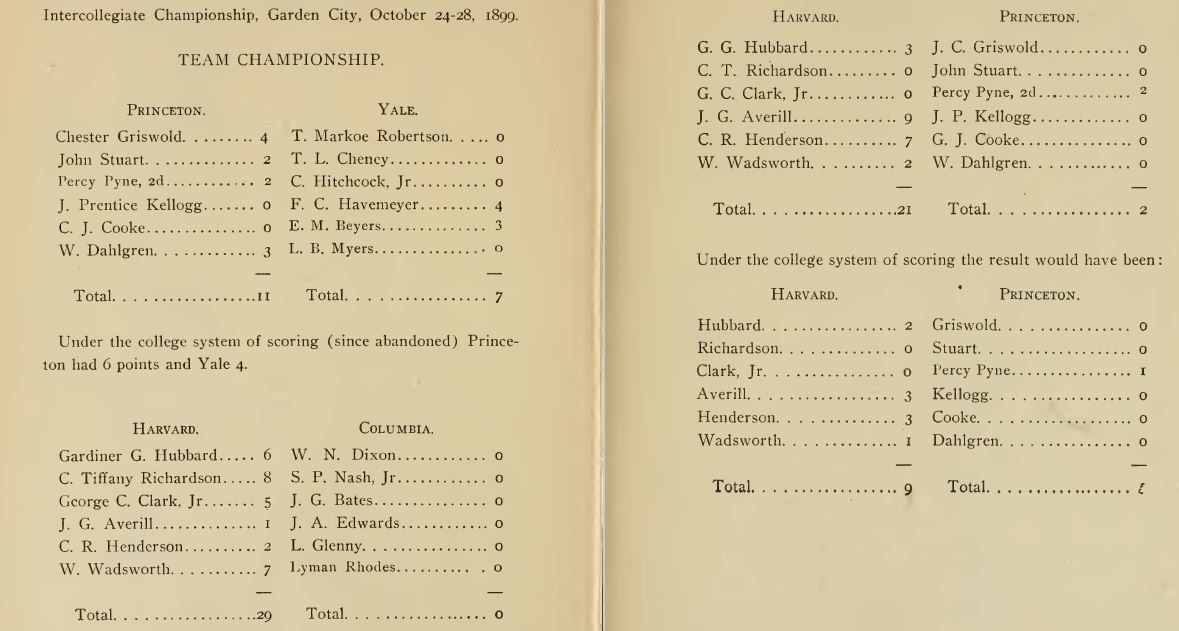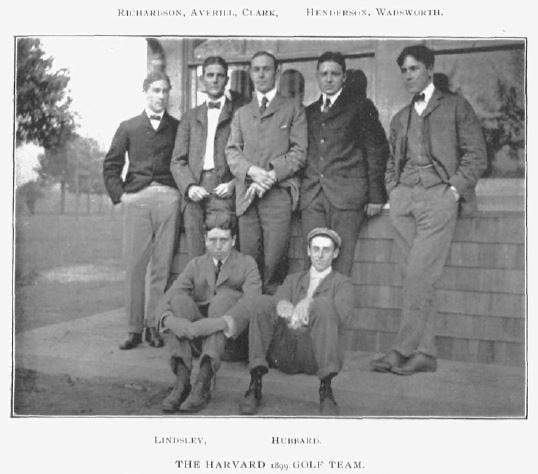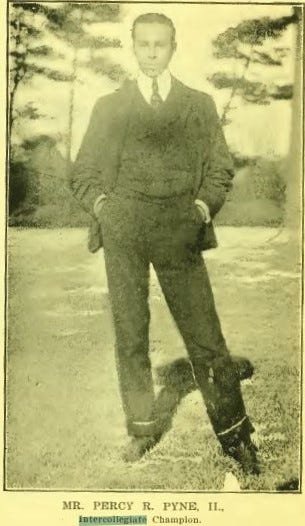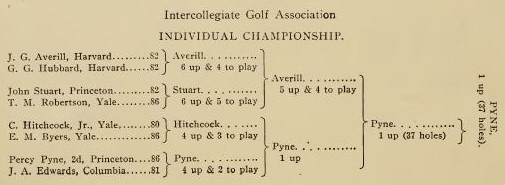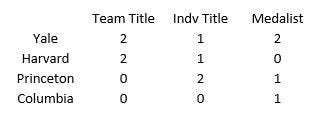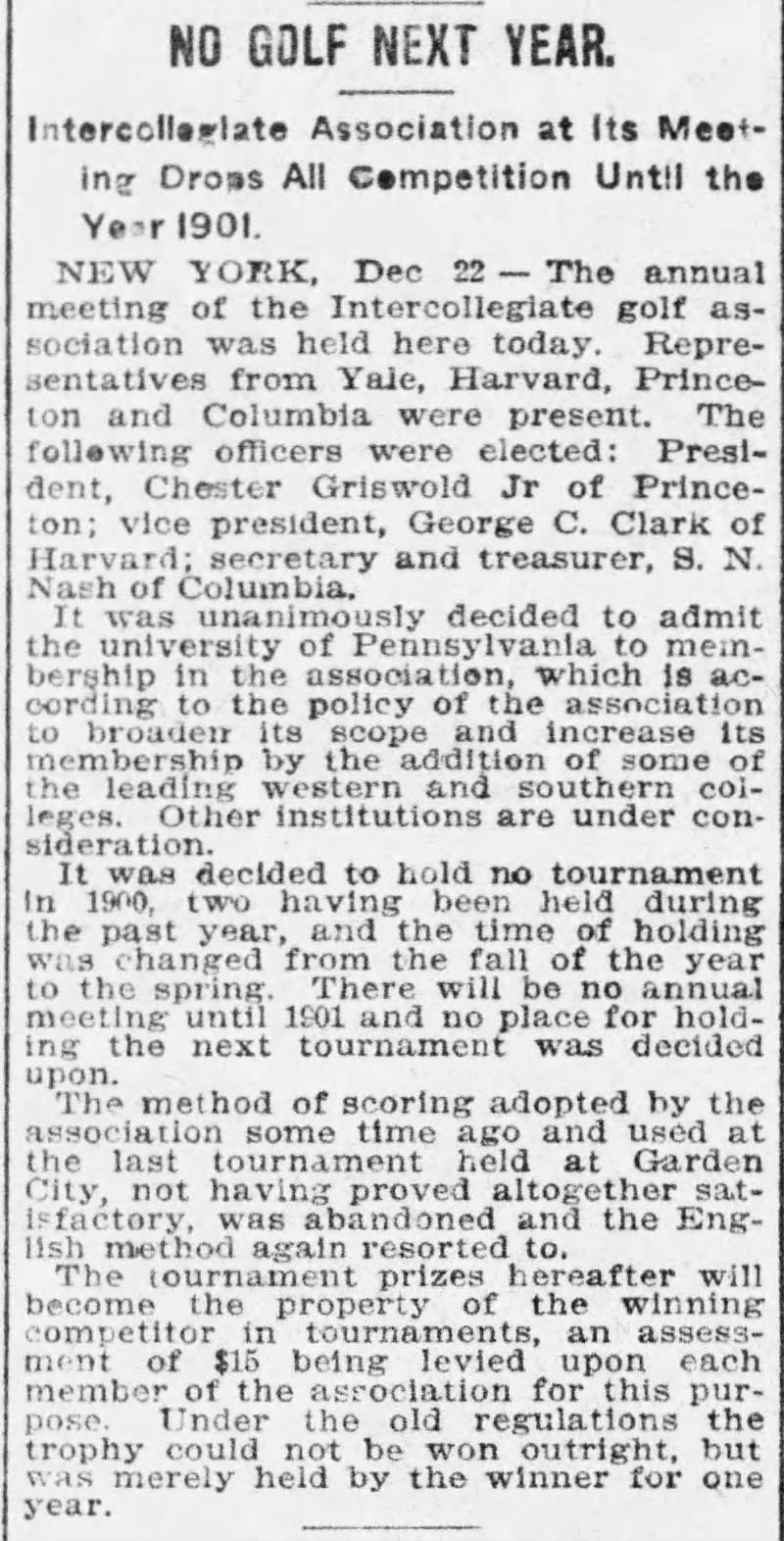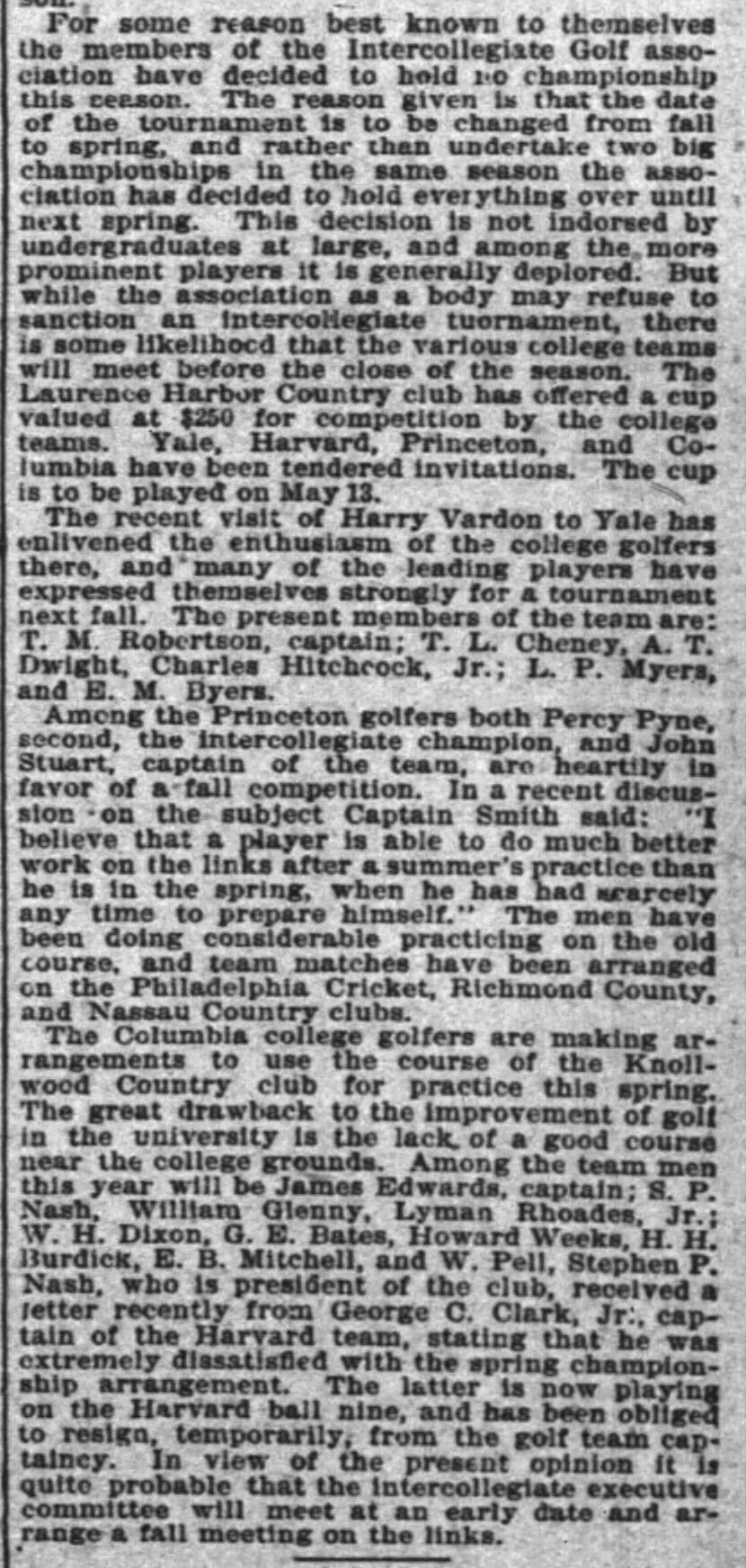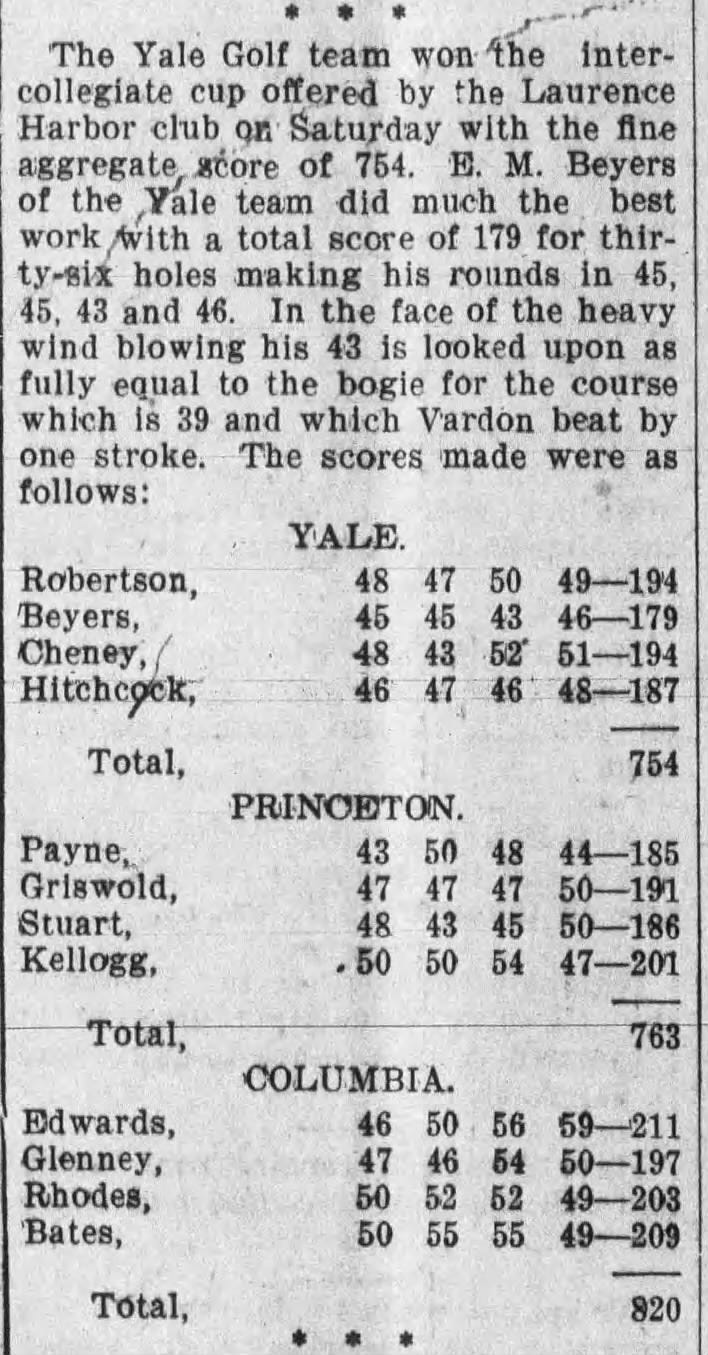This is part of a series on the Men’s Collegiate Championships
IGA Championship Era: 1897-1938
“Good judgement is the result of experience and experience the result of bad judgement.”
-Mark Twain
Sometimes it takes a few bad decisions, or at least unpopular ones, to get things moving in a positive direction. There were a number of decisions made related to the 1899 championship and its aftermath that would prove to be not only “bad” but also important for the future of the championship. As mentioned before, keep in mind that the IGA was a student-run body which definitely affected the (short-sighted) decisions made early in the championship’s history.
Quick note: It may seem like we’re just covering every championship, but so many things happened in these early years that a significant focus of this series ends up being on these successive tournaments. As we move forward you will notice that the focus becomes less on the results (which can generally be found in the record book) and more on the storylines. Also, we will generally try to avoid hitting on too many well-known or thoroughly covered events for this particular series.
Intercollegiate Championship #4: Oct 24-28, 1899
Host: Garden City Links (Garden City, NY)
One great decision was to play the first non-Ardsley-hosted championship at what was quickly becoming one of the most talked about courses in America, which would go on to host the US Amateur in 1900 and the US Open in 1902
Format
Team match play (4 teams, 6 players each, random draw)
New Scoring Format: a modification of the net holes won system used so that now the points applied towards the team total are:
Win by 1-2 holes = 1 point
Win by 3-4 holes = 2 points
Win by 5+ holes = 3 points
Individual stroke play qualifier (18 holes)
Individual match play (8 players, random draw, 36 hole Final)
Results
Team Champ: Harvard (2)
Yale lost their best player, the reigning champ John Reid Jr, but they gained an incredible talent in freshman Charles Hitchcock and were confident the Ardsley Cup was still practically theirs. That made Princeton’s first round victory all the more surprising, setting up the first Finals that wasn’t Harvard vs Yale. By contrast, Harvard’s tournament was completely predictable. In the end, Harvard had evened up the team title count with Yale with their second consecutive victory. One oddity to note was that the team Finals was over 36-holes for the first time.
Even as good as the golf was said to be, most of the talk was about how much everyone hated the new scoring format. Meant to help prevent single match blowouts from deciding the entire team match, instead it left everyone unsatisfied as players figured out that at a certain point in the match it became moot to play any more holes. On at least two occasions someone simply walked off the course. It is heavily implied by more than one publication that they collectively decided to drop the format immediately after finishing the team portion, well before the annual meeting.
If you recall the team scores from the 1898 Fall championship that resulted in a tie under the old system, Yale would have won 7-4 under this new system.
Medalist: Charles Hitchcock Jr [Yale]
Yale’s new freshman phenom proved he belonged on the varsity stage by going out and shooting a new tournament stroke play low score of 80 to win medalist honors. It was clear from the beginning that he would play a large role in Yale’s future success.
Individual Champ: Percy Pyne 2nd [Princeton]
Everything about Percy Pyne 2nd (note: not Jr and not II) was said to be over the top. The son of one of Princeton’s largest ever benefactors, Moses Taylor Pyne, Percy would go on to pursue a life as a socialite rather than a golfer, but his impact on Princeton golf and even an interesting connection to the USGA headquarters went well beyond this championship title.
Pyne had an incredible tournament for anybody, much less a freshman. In the team matches he defeated Yale freshman sensation Charles Hitchcock and then scored Princeton’s only points in the Finals by defeating Harvard’s captain George Clark Jr. The Pyne/Hitchcock rematch was much closer in the individual semifinals and would have been the talk of the tournament if it hadn’t been for the thrilling end to the individual finals. The 36-hole Final got a late start (11am) and a late finish, needing an extra hole in the dark to end. Pyne’s heroics and pulling off seemingly impossible shots would be echoed some 90 years later by another phenomenal freshman from Arizona State.
Championship Award Count
Intercollegiate Championship #4: 1900 [Record Scratch]
The winter IGA meeting resulted in some expected news - the unfavorable scoring format was dropped and Penn was officially added as a participant in coming tournaments - but the biggest piece of news was the wholly unexpected announcement that there would be no tournament in 1900.
It seems that the desire was to move the championship back to the Spring (sigh) but the reasoning to forego a championship in 1900 being because there was already two held in 1898 was…confusing.
To say this was an unpopular opinion might be putting it lightly. The good news, though, was that a replacement tournament of sorts was already in the works by April, 1900.
The Laurence Harbor (Unofficial) Tournament: May 13, 1900
The folks at Laurence Harbor stepped up in a big way providing a venue for a very cool, very unofficial replacement championship. One of the most interesting aspects to this is the format - consisting of 4-man teams playing 36 holes for the team championship - is that it would become the official format about two decades later.
Yale took the Cup with a 4-man 36-hole score of 754. It is unknown at the time of this writing if Yale still holds this beautiful trophy, whose value based on the original purchase price would be north of $8k but whose value as a historical object for college golf probably can’t be calculated.
IGA Constitution: 1900
Despite the lack of a tournament, the IGA was still busy during the off year creating the official organizational constitution. This would be the guiding document for years to come, passed along annually to the new student President.
The articles are as follows:
Official name of the organization was “The Intercollegiate Golf Association of America” (but still abbreviated throughout the document as “IGA”)
A 2/3rds vote would admit any college in good standing into IGA membership
Two members from each organization act as representatives at the annual meeting. Another part of Article #2 was that a team had to play in the previous tournament to be allowed at the next meeting
Laying out the duties of the President, Secretary, and Treasurer
One meeting a year
Dues of $15 were collected annually from each team and failure to pay could result in immediate expulsion. This money went towards paying for the prizes
Amendments can be made by 2/3rds vote
The various by-laws that appear in the rest of the document are very interesting (or nap inducing depending on your level of history nerdiness I suppose), which we will touch on as they come up in future posts. The important thing to take away from this is that the IGA is officially official and the stage is set for a steady tournament bolstered by good decisions. Hopefully.
EXTRA HOLES: Something brewing out “West”
It’s easy to believe that the five schools we’ve mentioned so far were the only ones playing organized golf at the turn of the century when in fact there were a number of other universities and small colleges west (of the Eastern time zone) who were very interested in collegiate golf. Take note of the schools mentioned below and keep this in the back of your mind as ten years from now it’s going to come to a head in a fairly substantial way.
Thanks for reading!
Up Next:
In the next post we will cover the return of college golf with the 1901 championship where Harvard and Yale square up for permanent ownership of the Ardsley Cup.




